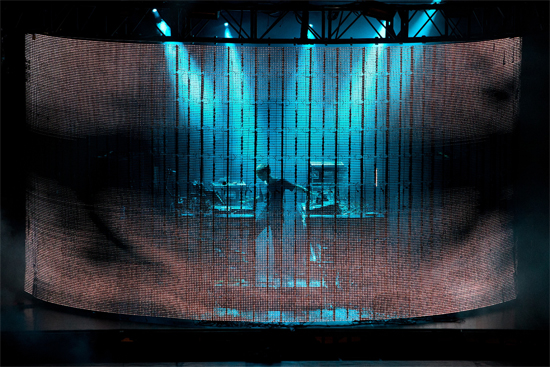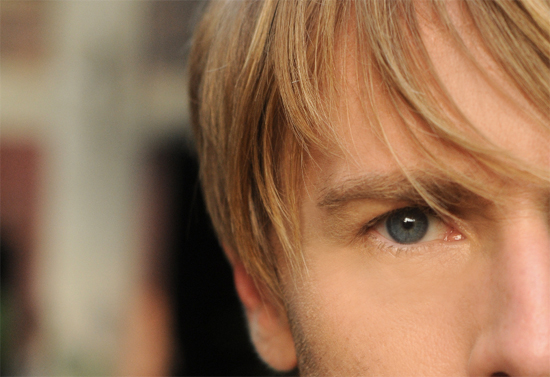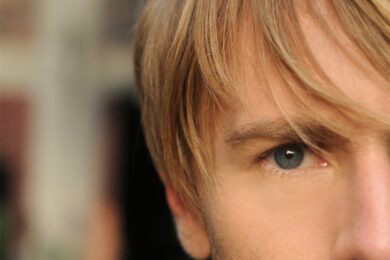It might seem like a tautology, but to my mind Richie Hawtin is a true techno modernist. From the germination of Plus 8 records with fellow Canadian John Acquaviva in 1990, through to his present day occupation(s) as head of M-nus records, international DJ and all-round techno entrepreneur, Hawtin’s focus has always been on taking steps into the unknown. Where other behemoths of the scene have continued to push things musically, his philosophy is far broader: a constant renewal of the very musical landscape he inhabits. There can’t be many on the scene who, in the course of their career, have gone from owning a vinyl cutting house to virtually abandoning the format.
Throughout our conversation, the activities of this Berlin resident prompt discussion of the future. This is techno as science fiction, constantly keeping one eye on the next decade and taking considered leaps in that direction. And for Hawtin, this fiction is very nearly a reality. It’s the next innovation in production or DJing technology, in digital music distribution or live multimedia. Some might call this fetishism for the 21st century. Others would hail him as a visionary.
Going back to Plastikman, then, is perhaps an unexpected step. But the moniker’s distinctive logo was always the most potent symbol of futurism in Hawtin’s arsenal: think of the psychedelic snare barrages of ‘Spastik’, or the slow burning, oppressive atmospheres of Consumed. And it’s still a futurist message he’s preaching, albeit through a series of live shows and the release of Arkives – a comprehensive roundup of the Plastikman discography – rather than through new material. Hawtin’s appetite for innovation knows no bounds when it comes to the live experience.
Already notorious for his use of cutting edge digital equipment in his DJ sets, Hawtin and cohorts have gone one step further with Plastikman live, a fiendishly complex multimedia event pairing re-performed music from the Plastikman discography with live-manipulated lighting and visuals. By all accounts this is more a concert than a club performance, prefigured by 2008’s M-nus label showcase, Contakt (which featured live lighting and wireless connectivity between performers and audience). But the Plastikman live experience is undeniably a first for the global underground: a gritty, uncompromising response to the shock-and-awe pyrotechnics which are de rigueur in more commercial spheres.
Detractors will see the Plastikman revival as a swindle. A glossy rehash of past glories with expensive lighting and lashings of technological gimmickry. But there’s not a glint of cynicism in Richie Hawtin’s eye. Only the faint but tantalising reflection of unexplored frontiers.
How are things?
Richie Hawtin: Well we’re having a big problem with flight cancellations here because of snow. I just had a phone call ten minutes ago saying we couldn’t go to Tokyo today because of that.
Have you been touring quite a bit?
RH: It’s been non-stop. I just flew in from Miami this morning where we did a 10 day North American bus tour. We did a lot of the places where Plastikman got its original hype and where it all began: Detroit, Toronto, Montreal, New York, Milwaukee, Chicago. It was really amazing.
And was that with the full Plastikman show?
RH: No, just DJing. The show right now is too large to take on the road! We’re planning to do that next Autumn, to take the whole show and really do a sustained tour. This year has pretty much been about highlight events around the world to kind of reintroduce Plastikman to the people of 2010.

I wanted to ask about the live show. I gather it’s got quite a multimedia aspect to it. Could you describe it?
RH: The basic idea with bringing Plastikman back to the stage was to hopefully do something different that wasn’t really happening out there. There are a lot of other live acts – especially electronic acts, bigger ones, like The Chemical Brothers, Underworld – doing these large-scale performances. But I find most of them, although they’re entertaining, are a little bit more pre-planned; their visuals are all synced up and you see pretty much the same thing every time. With Plastikman I wanted to create a multimedia show where one person on stage – which happens to be me – controls as much of the experience as possible, and has live control over that experience, which can change and create a different show each night. So on stage I’m using a whole bunch of technology, computer networking, wireless. And what that does is it gives me a direct connection to the lighting consoles, the visual computers and of course the audio.
Put all that together and you get this multimedia experience – a concert experience, but I develop it each night as I program different drums or bring in new loops, make those kind of decisions. Those decisions trigger all types of things; a certain snare pattern starts to create lighting patterns, a certain bassline manipulates what you’re seeing on the video screen. So it’s really immersive.
How do you find people respond to the show, as opposed to a standard DJ set?
RH: Well a DJ set has kind of a party atmosphere. You’ve got me right up front with people, in a direct connection. Whereas with Plastikman live I’m behind this curtain of LEDs. Plastikman live is supposed to be like a Plastikman album: it’s supposed to suck you in and draw you fully into this immersive environment for one hour. So where a DJ set can go all over the place from funky house to techno to minimal or whatever you want to call it, Plastikman is quite intense, it’s a tighter focus, and it’s supposed to really grab the power of that moment and create a very unique experience.
The crowds have been totally, I think, into it. Not everybody knows that I’m controlling everything – not everybody needs to know – but I think people feel that there’s something different about the show, by the combination of all these things happening. Things happen at the right time together, instead of a great lighting thing happening at one moment of a show, then a great audio thing later on, and then there’s a cool image on the video screens. We’re trying to bring all that together, so it’s synchronised, but still live, and gives all the power that bringing all these elements together can give.
Do you think this kind of show is the future of going to clubs? Do you think it’s going to become more widespread?
RH: Clubbing is about bringing people together: dancing, community, celebration, partying. And what we take in at a great clubnight is not only – has never been – just about music. It’s the feeling, it’s the people around, the intensity of the lights – or the lack of light. All these things that we take in through our senses create a moment that we want to remember for the next weeks or even the rest of our lives. There’s always going to be great clubnights with just DJs playing music or great bands or whatever, but I think there is a future in these – I don’t want to use the word multimedia – but these performances, these shows that give us stimuli in multiple ways, that are nearly physical; that take us into these non-realities that nearly feel like a physical reality.
It seems like there’s a hefty amount of technology involved in the show, and your DJ sets are famously hi-tech. How important is technology to you? More so than music?
RH: It’s really hard for me to separate which came first. As a kid I was programming computers and building little science kits with my Dad and watching him take apart computers, so there was always lots of technology around me. But there was also my Dad playing lots of music, playing Kraftwerk, Pink Floyd, The Beatles, whatever. That was kind of the environment, my incubator, even before I knew. So I wouldn’t be really comfortable saying that music is the most important or technology is the most important, it’s that integration of both of them. For sure, I’m interested in visuals and all these different types of things, but the two core things of what I’ve been about since the beginning is music and technology.
Do you find that symbiotic relationship between the two is common to a lot of producers of dance music?
RH: Yeah, I think a lot of the producers in dance music are basically computer nerds, you know! [laughs] Who’ve learnt to be musicians or entertainers. But we’re just a new breed of musicians who use a different technological tool. To me, when the guitar came out it was the most cutting edge technological tool you could use to make music, before that it was a flute, before that it was just your voice or banging on rocks. So now we’re learning how all these new, hi-tech things that we produce as humans can allow us to delve deeper into our creativity. Well, maybe deeper or maybe just in a different way. I love that our tool set is always updating and changing. That’s what keeps the music and my interest alive.
With that in mind, I wanted to talk about the old vinyl vs. digital debate. Obviously you’re firmly on one side of it. What are your views on vinyl as an industry in the 21st century? Do you think it’s on its way out?
RH: Somebody asked me this just the other day. I definitely have a long term connection to vinyl. My first days of listening to music were always about that medium. But for me, the possibilities of the digital distribution system outweigh my nostalgic love for vinyl. I do feel it has a future in the near term. People love physical objects, and I think the vinyl format has much more life than the CD format – there’s nothing about the CD format that can’t be replicated with digital distribution. The artwork is so small it’s not that special. Vinyl still has weight, but I do question whether the format that it’s in now will continue. It’s a petroleum-based product, it’s not very green or environment-friendly, so perhaps there needs to be some kind of update on that.
But music defines us. When you meet someone, whether you want to admit it or not, you take in visual stimuli – their jacket, their shoes, their pants, their makeup, their hair – before you get to speak to them. That’s part of what gives you a clue that maybe you want to know this person. Another clue is maybe going to their house later and seeing what albums or books they have on their shelves. Sometimes it’s kind of hard to peer into someone’s iPod and see what’s in there! [laughs] So I do feel that people will need – for quite a long time, because we’re humans – physical objects. We’ll need physical objects that represent music that we love, you know. But perhaps that will be an object that’s connected to a release. It may not be a musical carrier, it could be a stuffed animal, it could be a sculpture; something that ties you to who you are and what you feel connected to.
The branding and visual side of your music, and of music in general, is obviously very important to you. When was that something you started to get interested in?
RH: Honestly, that’s been an issue since the first Plus 8 release in 1990. It was very important for John Acquaviva and I to have a strong visual identity for Plus 8. And that grew into when Plastikman came out, into M-nus and everything I’ve been associated with since. Also, going back to the vinyl thing, it’s great to have a vinyl album with a beautiful cover. But it’s also, I think, really nice that if you go to M-nus.com now, for the last four or five years, every release has a small movie. I think seeing music become more related to moving visuals is also a development that wouldn’t have happened if we’d stuck to just the vinyl format. Music and visuals have always gone together to give more depth or power to the musical idea that you’re listening to. Sometimes you’d sit in your bedroom – or I did – listening to a Prince album and just looking at the album cover, reading all the notes on it for hours and hours. Do I miss that? Yes, but when I see a great new release and a movie to go with it, I get sucked into that experience again and I watch that little movie over and over. So it’s still there, it’s just being presented in a different way.
You spread your time over a number of activities – running the label, touring, making music. How do you find that balance? You must be exhausted a lot of the time?
RH: I’m not exhausted all the time but we do have moments of exhaustion! I’ve always been interested in multiple things at any given point, and if I’m really into something I’m very driven and very inspired. I really believe in what we’re doing at M-nus, and in every project that I’m doing. So I multitask, I try to do as much as possible. I sleep when I’m tired and as soon as I wake up I get up [laughs]. And I work and do what I love. It’s a lot of work, but there’s a lot of reward that comes out of it.
Do you ever feel like the organisational side of things keeps you from making as much music as you’d like?
RH: For sure. There’s always a give and take with having a label and being a businessman and a creative individual at the same time. Sometimes I miss not being in the studio as much as I was in the early days, but then I take a step back and look at what we’ve been able to do with M-nus over the last 10 years. I look at people like Gaiser and Marc Houle having their own artistic freedom and careers, and then I don’t feel so bad. I think at the end of the day even on the business side, I try to keep it as creative as possible, keeping M-nus as forward thinking as possible. For example, coming up with an idea like Contakt, which brings all my artists together to perform. That may have taken time out of my studio but then I’m on stage with everybody, we’re doing something that nobody else had been doing at that point. So it’s all part of the same continuum, of this push forward.
Do you think having a creative business approach helps you to bring to life these huge projects – the big live shows and tours?
RH: For sure. Everything that works now on a business level came out of the creative level. At the beginning there was no rulebook on how to start a record company, so me and John Acquaviva made the business side on the foundation of these creative ideas we had, and I think that’s always helped us. You can come up with the ideas like Contakt or for Plastikman live, but actually putting them into use, getting the right components, technology and people to come together to make it work is part of the challenge.
We could have come up with an idea for Kontakt or Plastikman live and found a company that specialises in touring or producing live shows. But we chose to do it in-house, and once it all comes together you know that you and your team have done it by yourselves. That goes back to the whole idea of starting a record company: in 1990 Plus 8 was, ‘Let’s do it ourselves, let’s have our own independent company and slowly build it.’ That’s still the ethos.
Finally, why now for a Plastikman revival? Do you think there’s something in the musical climate?
RH: Plastikman always has to go by a feeling. I have to feel that there’s something missing or something new to say. Sheet One came out because I didn’t feel that there were many interesting long form electronic albums in 1993. Everybody was making compilations of their singles and I felt there could be a deeper, more immersive experience. I went into the studio with that idea and Sheet One came out. Consumed came because I wanted to take people deeper and change the whole viewpoint of what Plastikman was or should be. And again now, I feel electronic music is growing, has this huge new fanbase, there are these big live shows. I just felt that if I brought Plastikman back, I would do things differently, and I think Plastikman live in its current incarnation needed to be there. It’s large scale on one level, but it’s also quite visceral and underground, and I didn’t feel that there was anyone doing that. Plastikman Arkives was to kind of back that up, and to give all the new electronic music fans out there, specifically the new DJ Richie Hawtin fans, a bit of the back story, the foundation of how I got here, how M-nus got here. Without Plastikman, none of this big success over the last 10 years would have been possible.



